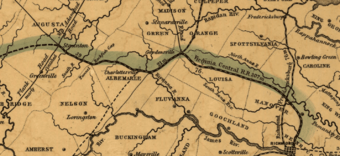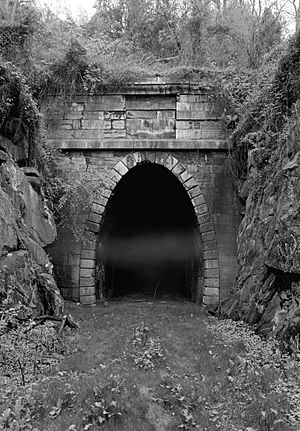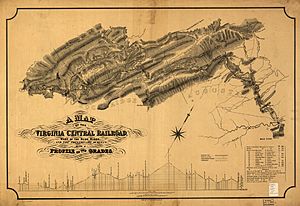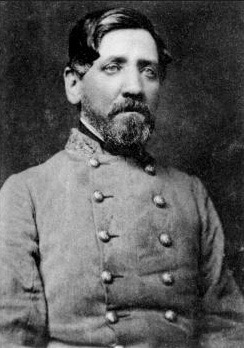Virginia Central Railroad facts for kids

1852 Map of the Virginia Central Railroad
|
|
| Overview | |
|---|---|
| Headquarters | Richmond, Virginia |
| Locale | Virginia |
| Dates of operation | 1850–1868 |
| Predecessor | Louisa Railroad |
| Successor | Chesapeake and Ohio Railroad |
| Technical | |
| Track gauge | 4 ft 8 1⁄2 in (1,435 mm) |
| Length | 206 miles (332 km) |
The Virginia Central Railroad was an important early railroad in the Virginia state. It operated from 1850 to 1868. The railroad stretched about 206 miles (332 km) from Richmond west to Covington.
It began in 1836 as the Louisa Railroad. The Virginia General Assembly gave it permission to build tracks. The railroad started near the Richmond, Fredericksburg and Potomac Railroad line. It grew westward, reaching Gordonsville by 1840.
In 1849, the Blue Ridge Railroad was created. Its job was to build tracks over the Blue Ridge Mountains for the Louisa Railroad. By 1852, the Louisa Railroad reached the base of these mountains. After a decision from the U.S. Supreme Court, the Louisa Railroad could expand east to Richmond.
The railroad changed its name to the Virginia Central Railroad in 1850. It used a temporary track over Rockfish Gap to get around the Blue Ridge Railroad, which was still being built. This connected the eastern and western parts of the railroad. By 1857, the railroad reached Clifton Forge. It started using the completed Blue Ridge Railroad in 1858. The railroad kept planning to expand until the American Civil War began in 1861.
During the war, the Virginia Central was a main target for attacks. Union Cavalry often raided it. The war left most of the railroad damaged. But by July 1865, the railroad was running again over its full length. After the war, Williams Carter Wickham became president. He helped the railroad expand towards Covington.
In 1868, the Virginia Central Railroad merged with the Covington and Ohio Railroad. They formed the Chesapeake and Ohio Railroad. This new railroad expanded west to the Ohio River by 1873. This happened after Collis P. Huntington helped with new money. The Chesapeake and Ohio Railway continued to operate for over 100 years. Today, CSX Transportation, Amtrak, and the Buckingham Branch Railroad still use parts of the old Virginia Central line. They carry freight and passengers.
Contents
Building the Louisa Railroad
The Virginia General Assembly approved the Louisa Railroad company on February 18, 1836. The company was to build a rail line west from the Richmond, Fredericksburg and Potomac Railroad (RF&P). The plan was to connect near Taylorsville, which later became Hanover Junction. The line would go west through Louisa courthouse to Orange County.
The Virginia Board of Public Works owned a large part of the company's stock. This money helped pay for the first part of the railroad. Construction started in October 1836. The line reached Louisa courthouse by 1839 and Gordonsville by 1840.
The original plan was to build across the Blue Ridge Mountains to Harrisonburg. But in 1839, a new route was surveyed. This route would go to Staunton through Charlottesville. This path, over Rockfish Gap, was chosen as a better option.
In 1847, the railroad's plan was updated. It allowed construction to the eastern base of the Blue Ridge. In 1849, the Blue Ridge Railroad was formed. Its job was to cross the mountains at Rockfish Gap to Waynesboro. Claudius Crozet was the chief engineer for this project. He oversaw the building of four tunnels through the Blue Ridge. Meanwhile, the Louisa Railroad reached the Rivanna River near Charlottesville by 1850. By 1852, it reached Mechums River, near the Blue Ridge Railroad's eastern end.
The RF&P first managed the Louisa Railroad's operations. The first train ran on December 20, 1837. In June 1847, the Louisa Railroad took over its own operations.
The Louisa Railroad's eastern end was at Hanover Junction. This connected with the RF&P Railroad. An earlier law protected the RF&P from competing lines. But in 1848, the Virginia General Assembly allowed the Louisa Railroad to extend east to Richmond. The RF&P protested this, saying it broke the old law. A Virginia State Court first ruled against the RF&P. It said the Assembly could allow other railroads. The court also said the old law only applied to passenger transport. The case went to the U.S. Supreme Court. The Supreme Court sided with the Louisa Railroad.
Frederick Overton Harris was the first president of the Louisa Railroad. He served until 1841. Charles Y. Kimbrough followed him until 1845. Then, Edmund Fontaine became president. He continued to lead the Louisa Railroad and its next version until after the Civil War.
Expanding as the Virginia Central
While the Blue Ridge Mountain section was being built, the Louisa Railroad was busy. It built tracks west from the mountains, across the Shenandoah Valley to Staunton. In January 1850, the state allowed the Louisa Railroad to raise more money. This was for building from Staunton to Covington. On February 2, 1850, the Louisa Railroad changed its name. It became the Virginia Central Railroad.
| Name (East to West) | Feet | Meters |
|---|---|---|
| Blue Ridge Mountains | ||
| Greenwood | 536 | 163 |
| Brooksville | 864 | 263 |
| Little Rock | 100 | 30 |
| Blue Ridge | 4,263 | 1,299 |
| Ridge-and-Valley Appalachians |
||
| Millborough | 1,335 | 407 |
| Mason's | 323 | 98 |
| Coleman's | 355 | 108 |
To connect the railroad's eastern and western parts, a temporary track was built. This was needed because the Blue Ridge Railroad was not finished. Charles Ellet, Jr., the chief engineer, suggested it. By 1854, this temporary track was in use. It went over and around the Blue Ridge Tunnel. This track, called the Mountain Track, was about 4.38 miles (7.05 km) long. It had very steep slopes and sharp turns. Trains had to go slowly, about 5-7 mph (8-11 kph).
Three small tank locomotives were ordered for this temporary track. One was from the Tredegar Iron Works in Richmond. Two others came from Baldwin Locomotive Works in Philadelphia. These temporary tracks helped connect the railroad. They saved money and effort by avoiding moving goods and people off trains to cross the mountains. This helped the railroad grow further west.
Construction continued from Staunton. By 1855, it passed through a gap near Goshen. By 1856, it reached Millboro. This western part of the line had three more tunnels. A temporary track was used at Millboro while a tunnel was finished. By 1857, the railroad reached Jackson's River Station. This spot is now known as Clifton Forge. It became an important stop for the Chesapeake and Ohio Railway.
The temporary track over Rockfish Gap was used until April 1858. That's when the Blue Ridge Tunnel opened. The last train used the temporary track on April 12. The next morning, the mail train was the first to go through the new tunnel. The temporary track was then removed. When finished, the Blue Ridge Tunnel was the longest tunnel in the United States. It was also the first in the country built without vertical shafts. The Virginia Central did not own the Blue Ridge Railroad. But it was allowed to use it by paying a yearly fee to Virginia.
In 1859, the Virginia Central carried many passengers and tons of freight. The line connected Richmond to a point about 10 miles (16 km) east of Covington. This was where the planned Covington and Ohio Railroad would start. The total distance was about 195 miles (314 km). In 1853, Virginia had approved the Covington and Ohio Railroad. It was to extend the line west to the Ohio River. This company started work in 1855. It did important grading work in the mountains. But the Civil War stopped its expansion in 1861.
Civil War Challenges
| Type | 1861 | 1862 | 1863 | 1864 |
|---|---|---|---|---|
| Passenger | 19 | 16 | 16 | 16 |
| Mail and Baggage | 12 | 8 | 8 | 8 |
| Conductor Cars | 3 | 8 | 8 | 6 |
| Box and Stock Cars | 150 | 101 | 110 | 89 |
| Platform and Gondola Cars | 30 | 27 | 36 | 36 |
| Hay Cars | 8 | 4 | 4 | 2 |
| Gravel and Sand Cars | 22 | 22 | 22 | 22 |
| Total | 244 | 186 | 204 | 179 |
The Virginia Central was very important for the Confederacy during the war. It linked the rich farmland of the Shenandoah Valley to Richmond. This made it easy to move supplies and troops. The Blue Ridge tunnels and the Virginia Central helped Confederate General Stonewall Jackson's "foot cavalry" move quickly. The railroad also carried mail for the Confederate States Postal Service. This service, along with passenger and goods transport, became less reliable. Military transport became the main focus.
As the war went on, the railroad fell apart. It was used constantly, and supplies for repairs were hard to find. Union raids also destroyed many parts of the line. Most of the railroad's depots were ruined. But the depots at Gordonsville and Charlottesville, which were key trade points, were saved. After a battle near Waynesboro, many bridges and tracks were destroyed. As Union armies moved towards Richmond, the eastern part of the railroad was also damaged. By the end of the war, less than 20 miles (32 km) of track were working.
During the Peninsula Campaign in 1862, Union cavalry destroyed the South Anna River bridge. The line between Hanover and Atlee was also torn up. Even though there was much damage, repairs were made quickly. The line usually stayed in good use. In May 1863, another raid attacked the line. The Louisa Court House was attacked, and the Hanover depot was burned.
During Ulysses S. Grant's Overland Campaign in 1864, Phillip Sheridan was ordered to destroy the Virginia Central. He had nearly 8,000 men. They were to join David Hunter in Charlottesville. From there, they would attack Richmond from the west. Robert E. Lee sent cavalry to stop Sheridan. They met at Trevilian Station on the Virginia Central line. Confederate forces pushed Sheridan back. He withdrew on June 12. Little damage was done to the tracks during this raid. The damage was quickly fixed, and the line was back in operation.
Rebuilding the Railroad
Rebuilding the Virginia Central started soon after the Confederacy lost the war. General Edward Ord gave permission for repairs on April 21, 1865. Temporary bridges were built, and repairs were made fast. Trains could run to the Rivanna River by May. Temporary routes using wagons were set up to bypass broken sections. These helped transport goods and passengers while repairs continued. By the end of July, trains could run to Jackson's River Station.
The Virginia Central's trains and equipment were in bad shape after the war. There wasn't enough working equipment for the demand. To help, four locomotives and forty cars were rented from the government. The Beaverdam Depot was rebuilt in 1866.
In November 1865, a new president was elected. Former Confederate General Williams Carter Wickham won. He beat Edmund Fontaine, who had been president for a long time. The company's owners thanked Fontaine for his hard work. They gave him and his family free tickets for life. Fontaine was reelected president in 1866 and 1867.
Becoming the Chesapeake and Ohio Railroad
Before the Civil War, a 10-mile (16 km) section of the line was not finished. This was between Jackson's River Station and Covington. This part was needed for the railroad to expand further west. By July 31, 1867, the last of the track was laid. This connected the Virginia Central with the Covington and Ohio Railroad. A state law from March 1, 1867, allowed these two companies to merge.
On August 31, 1868, the Virginia Central merged with the Covington and Ohio. They formed the new Chesapeake and Ohio (C&O) Railroad. Wickham was elected president. Wickham knew they needed a lot of money to build through the mountains. The state could no longer help as much. Wickham found new money by getting Collis P. Huntington involved. Huntington was one of the "Big Four" businessmen. They had just finished the western part of the transcontinental railroad. With Huntington's help and new money from New York City, construction west started again in 1868.
The C&O had always paid to use the state-owned Blue Ridge Railroad. But on April 1, 1870, the C&O bought the line from Virginia. The Virginia Central and C&O paid about $900,000 to the state. This included the purchase price and earlier fees. This was much less than the state had spent building the line.
Construction of the old Covington and Ohio line began from both ends. It started from Huntington, West Virginia in the west and Covington in the east. It moved towards the middle. By July 1869, the line reached White Sulphur Springs, West Virginia. With temporary tracks around unfinished tunnels, the entire 227-mile (365 km) line from Richmond to White Sulphur Springs could be used. In August 1871, a train called the Greenbrier was brought down the Ohio River. It helped build the line from the western side.
The final spike for the 428-mile (689 km) line was driven on January 29, 1873. This happened at the Hawk's Nest railroad bridge. C.R. Mason drove the last spike. He had also driven the first spike of the Louisa Railroad.
Huntington also saw the chance to ship coal from West Virginia. His agents bought land in Warwick County in eastern Virginia. In the 1880s, he oversaw the extension of the C&O's new Peninsula Subdivision. This line went from Richmond to Newport News. There, the company built coal piers on the harbors of Hampton Roads and Newport News.
The Richmond and Alleghany Railroad merged into the Chesapeake and Ohio in 1889. This line went from Clifton Forge to Richmond, following the James River. It allowed trains to go down nearly 1,000 feet (300 m) in elevation to Richmond. This "James River Line" helped the C&O avoid the steeper hills of the old Virginia Central line. It became the main way to transport coal east. The older Virginia Central line was then used for empty coal cars going west.
Modern Uses of the Line
In the 1980s, the Chesapeake and Ohio merged with other railroads. They formed CSX Transportation. The line built by the Virginia Central from Staunton to Clifton Forge was almost closed. But CSX decided to keep it. They use it to route empty coal trains west. This is now a common practice.
Besides CSX, other railroads use parts of the old Virginia Central line. Amtrak's Cardinal train uses it from Gordonsville to Clifton Forge. The Buckingham Branch Railroad, a smaller Virginia railroad, also leases parts of the line from CSX.
Many years after the first Virginia Central became part of the C&O, another railroad used the name "Virginia Central." This railroad ran between Fredericksburg and Orange. It was first called the Potomac, Fredericksburg & Piedmont Railroad Company (PF&P). It operated a narrow gauge line for 38 miles (61 km). In 1926, the line was changed to standard gauge. Its name became the Virginia Central Railway. Most of this line was closed in 1937. Only a 1-mile (1.6 km) part in Fredericksburg lasted until 1984.
Images for kids







